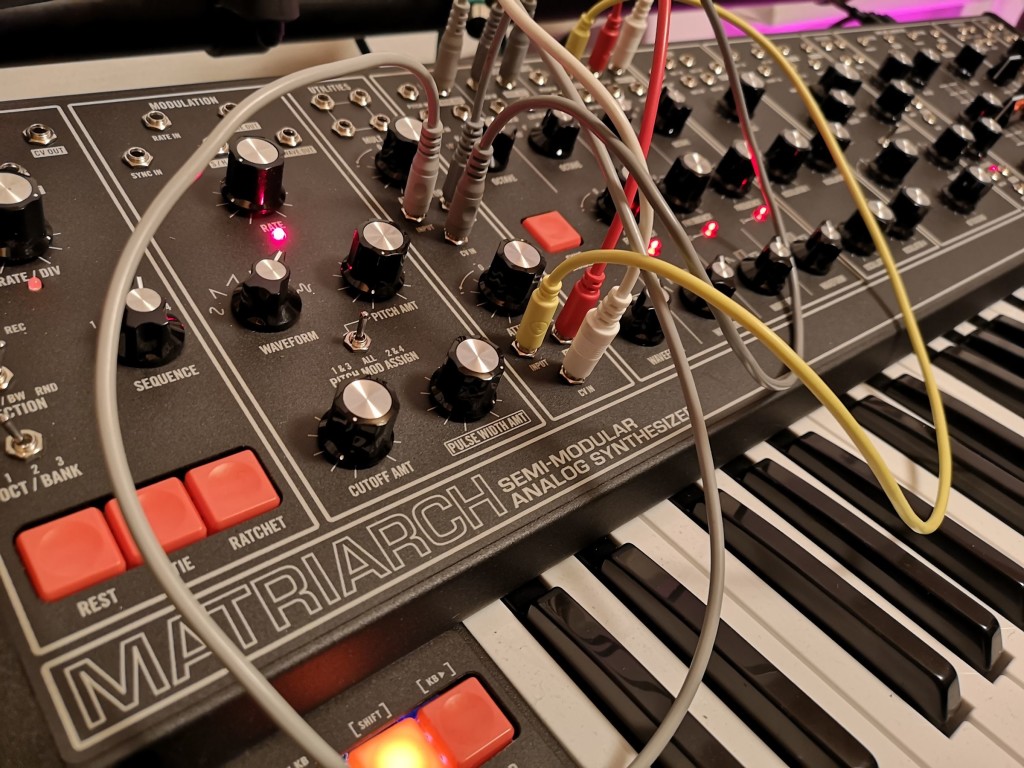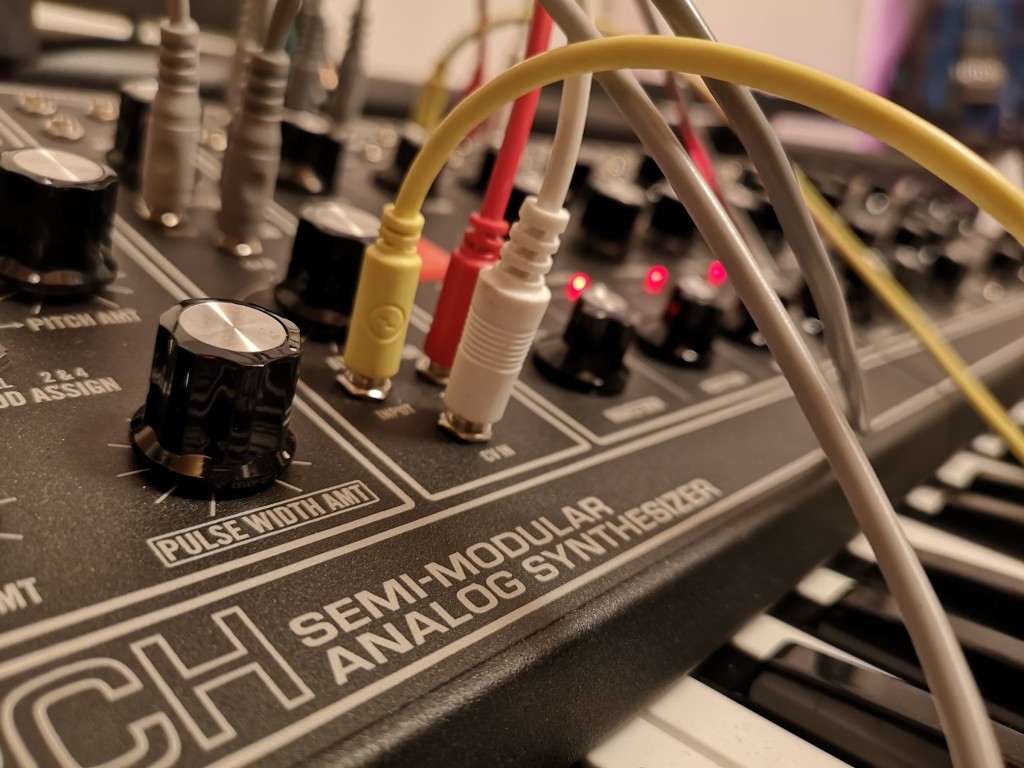We finish out our Deep Dive guide to the Moog Matriarch with some live jams and a round-up of tips – and an overview of why playing this instrument really is playing with voltage.
And we’ve covered so much here with the Matriarch, it’s good to wrap up all of it in once place. (These tips are then applicable to the Grandmother or other Moog modular/semi-modular technique, too.)
Our guide to the Moog Matriarch is presented as a sponsored partnership with Moog Music. Thanks for the support!
Some closing thoughts… Over six years ago, I was at Moog headquarters covering the launch of their first 900 series modular remake, the revival of the Keith Emerson modular, for Keyboard. To be honest, at the time it seemed to the world like remaking that instrument was a historical curiosity – like a odd way to invest time and resources. But the engineers’ argument at the time was that doing so meant they could better understand those historic modules from the inside out. I remember asking if that could lead to something new. Well, the Matriarch feels like the fruit of that effort. It’s informed by obsessive details of the Moog modular, but it is a genuinely new and coherent instrument.
It’s reasonably easy to clone a simple instrument or component, but maybe the better goal is fluency – being able to make something new, as if it’s a language.
Now having looked at the details of how these components work from an engineering perspective, it’s satisfying to play with them.
DC offset jam
Mark from Moog spoke about how you can actually feed modulation signals directly into the mixer, and then sum them with audio signal. I went a bit wild with that, and it really shows how the Moog approach lets you work with raw voltage and even clipping. I also play with the sensitivity of the envelopes, envelope modes, and “play” the voice switch (toggling between monophony and 2- and 4-voice paraphony).

Here is the same patch, formed into something more musical:
It’s a raw, single element, but I do love the material quality of it – it’s something I might play with in a larger composition, and at least it makes a break from what you normally hear in demos. I think it gets to some of that visceral quality the Matriarch has.

More advanced tips
Two bonus tips from Moog’s engineer, Mark Crowley.
First, you can do a lot with oscillator sync, again. (Really, you can do a whole lot – and while these sounds do emerge from some of the design of the original 900 series, I’d say that really digging into this is more of a 2020 sound than a vintage sound, at least to my ears.)
Hard sync, further out. Oscillators only send sync pulses to the next oscillator that they generate on their own. So if an oscillator is being synced and lower in frequency than the oscillator syncing it, it will not generate its own sync pulses and if a downstream oscillator is synced to it, the downstream oscillator will just run freely. If an oscillator is being synced and higher in pitch than the oscillator syncing it then the downstream oscillator can get uneven sync pulses (like if an oscillator resets twice before being synced you’ll get two sync pulses then a gap) but the total period of the sync pulses will be the same as the upstream syncing oscillator. I was experimenting the other day with quantized sequences from the Subharmonicon transposing oscillators in a way that sometimes cause downstream oscillators to go in and out of different syncs, which was cool.
There are also possibilities in playing with the frequency relationship of the LFO, relative to the arpeggiator:
Fun with LFO stair step wave. It’s the modulation oscillator triangle wave sample and held at each rising edge of the arp clock. This is can be a ton of fun as a modulation source. If you run the mod oscillator very slow you can get typical up and down stepped modulations (like a pendulum arp), but if you run the triangle faster than the arp clock you can get a sample and hold that will be based on the frequency relationship between the arp clock and modulation oscillator. This can ether sound like a loop of steps or pseudo-random as the oscillators phase relationships shift.
And yes, this can all work with the Subharmonicon in interesting ways.

Tips at a glance – instant recipes!
Refresher on all our tips, including advice from CDM resident artist Lars Hemmerling, Moog resident artist Lisa Bella Donna, and Moog engineer Mark Crowley (who designed this!).
Centering the mixer knobs is actually full gain with a little drive added. For clean signal, turn slightly to the left of 12 o’clock. To increase overdrive and add distortion, turn up to the right.
Always Be Attenuating. The attenuators are terrifically useful for managing signal – and inverting signal is useful for many techniques, too, including subtle modulation and stereo. (So for instance, flip a signal and route it to the second filter, then use the two flipped signals as stereo outputs in STEREO filter mode, or the same with the VCA in SPLIT mode.)
The attenuators also allow ring modulation: carrier (input), modulator (cv input), output.
MULT is wired in parallel, so you can use it both to route a single input to two or three outputs, and to passively mix multiple inputs into a signal output.
Don’t forget the second LFO, located in the UTILITIES section on the right.
Route the envelopes back to filter cutoff 1 and 2 for more control, or to other parameters (like PWM)
Use envelope end to create looped envelopes (routing trigger back into the envelope)
Mod wheel is a convenient way of controlling expression – route it and other settings (like aftertouch) from the back panel
Oscillator sync lets you apply controlled modulation with everything in tune, and you can toggle it off and on using SYNC ENABLE (plus convenient sync buttons underneath each oscillator).
For tremolo and amplitude modulation, set VCA Mode to ENV or SPLIT, and then use CV input to drive gain – from slow tremolo (at LFO rates) to full metallic amplitude modulation effects (at audio rates).
Use the stereo field. Try splitting the filters (SPLIT mode – left and right), use Spacing on the Stereo Delays, and patch other combinations – with SPLIT mode on the VCA, you have separate envelopes for left and right. You may actually want to carefully manage and attenuate what you’re doing so you don’t wind up with extreme left/right effects.
Check the Global Settings for more hidden options (like the sync bend mode for the delay), or use the unofficial online editor for easy access.
Yes, you can microtune. Matriarch supports MIDI tuning tables in Global Settings. You don’t even need Aphex Twin around.
Play paraphony by flipping the paraphony switch, with and without retrigger enabled. And try the hidden Paraphonic Unison mode (in Global Settings, or key switching via the lowest two white keys on the keyboard). In Voice Mode 4, third and fourth notes played assign new pitches to oscillator 3 and 4, respectively.
I’m keeping this guide by my Matriarch for late night inspiration…
The full deep dive
Don’t miss our full Matriarch special.
Introduction to the synth, and conversation with Moog engineering and artist resident:
Module by module:
Patch notes and diagrams: